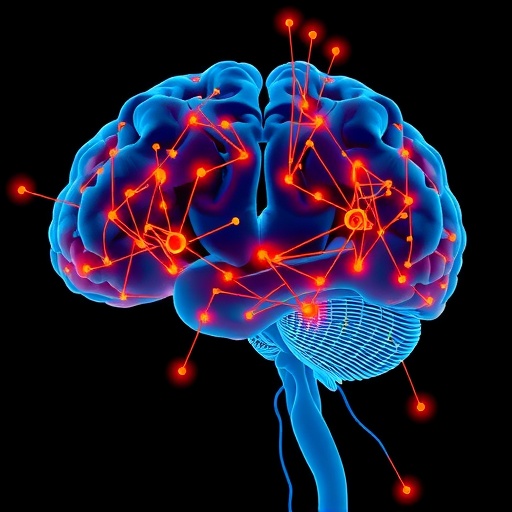From birth, the human propensity for survival is intricately tied to the capacity to connect and engage with others. This fundamental ability is critical for healthy emotional and cognitive development, yet it is markedly impaired in those diagnosed with autism spectrum disorders (ASD). Early in their lives, typically within the first year, children with ASD exhibit a pronounced lack of interest in social stimuli, which raises profound questions about the underlying neurobiological mechanisms driving this disconnection. Recent groundbreaking research conducted at the University of Geneva (UNIGE) seeks to elucidate these mechanisms by integrating findings from both clinical and animal studies.
In their innovative research, scientists discovered significant defects within the communication pathway that links two crucial brain structures — a finding that underscores the neural underpinnings of social interaction difficulties experienced by children with ASD. These findings have been documented in a recent publication in the journal Molecular Psychiatry, which highlights the relationship between neural communication deficits and the challenges faced by ASD children in understanding social cues.
With the prevalence of autism reaching alarming figures—current estimates suggest that approximately one in 36 children are now diagnosed with an autistic disorder—understanding its implications on cognitive development is paramount. Alarmingly, it is noted that nearly one-third of these children may be at risk for cognitive impairments. According to Dr. Camilla Bellone, an Associate Professor in the Department of Basic Neurosciences at UNIGE, the cognitive challenges seen in many autistic children stem largely from their impaired ability to decode social interactions. Because these children are less attuned to social signals from a young age, their development of essential social tools required to navigate the complexities of interpersonal relationships is significantly hindered.
At the forefront of this research effort is the Synapsy Centre for Research in Neuroscience for Mental Health, which is an interdisciplinary initiative blending neuroscience and psychiatry to forge new insights into the nature of social interaction. The crux of their findings reveals a dramatic correlation between a child’s ability to shift attention between various stimuli and the maintenance of ongoing social interactions. This notion is underpinned by preclinical studies utilizing mouse models that simulate conditions of ASD.
In particular, researchers provided compelling evidence using mice that lack the Shank3 gene, a gene known to be most commonly associated with ASD in humans. The observed orientation deficits in these mice toward their social counterparts echoed the social interaction challenges commonly described in children with ASD, reinforcing the usefulness of this model in studying the disorder. Dr. Marie Schaer, also an Associate Professor at UNIGE, emphasized how these mouse models provide invaluable insights into the characteristics of social behavior abnormalities.
While previous studies have indicated the existence of a specific neuronal communication pathway critical for social orientation—linking the superior colliculus, a structure involved in directing attention, to the ventral tegmental area, a key part of the brain’s reward system—the current research takes it a step further. The scientists discovered that the neural synchronization necessary for effective communication within these regions is impaired in ASD models. This dysfunction profoundly affects how information is exchanged between these critical areas, which in turn leads to observable deficits in social behavior and orientation.
In a pioneering move to understand these neural changes in children, a team member, Nada Kojovic, developed a novel MRI protocol optimized for young children aged 2 to 5. The challenge of keeping such small children still for necessary imaging procedures presented a significant barrier, but through innovative habituation techniques and family collaboration, over 90% of the participant children were able to produce high-quality MRI images without the need for sedation.
The results from parallel investigations in both animal models and young human subjects revealed striking similarities, indicating a conserved neural circuit malformation in those with ASD. More importantly, the level of connectivity observed within this circuit has proven to be predictive of cognitive outcomes in the following year. While direct intervention on this specific neural pathway may still be on the horizon, this discovery points to avenues for behavioral intervention strategies designed to enhance children’s capacity to shift attention quickly between different stimuli from a young age.
Among the promising intervention approaches is a rigorous treatment method developed in the United States that has demonstrated efficacy in Geneva. This intensive regimen mandates a commitment of 20 hours per week over two years and has yielded notable cognitive improvements. On average, children undergoing this intervention have reported gains of approximately 20 IQ points, with an impressive 75% subsequently capable of integrating into mainstream educational settings.
As the research continues to progress, the implications for early intervention strategies are profound, offering hope for better developmental outcomes for children with ASD based on their neural circuitry. This innovative approach not only advances our understanding of autism but also bridges a critical gap toward creating effective and targeted interventions for affected individuals and their families.
In conclusion, the findings from the University of Geneva represent a significant leap forward in understanding the neurobiological deficits associated with ASD. By comprehensively addressing the intricate relationship between neural communication pathways and social interaction skills, the research lays essential groundwork for future strategies that could fundamentally alter the trajectory of developmental outcomes for countless children grappling with the challenges associated with autism.
Subject of Research:
Article Title: Translational research approach to social orienting deficits in autism: the role of superior colliculus-ventral tegmental pathway
News Publication Date: 5-Apr-2025
Web References: Molecular Psychiatry DOI
References: N/A
Image Credits: N/A
Keywords: Autism, ASD, Neurobiology, Social Interaction, Cognitive Development, Early Intervention, Brain Imaging, Shank3 Gene, Neural Pathways, Mouse Models, Behavioral Therapy.




